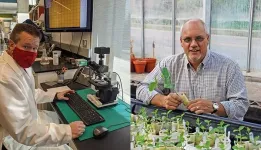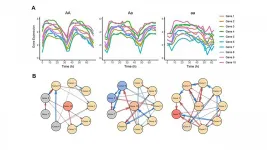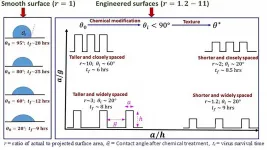(Press-News.org) You know that raw overwhelm people have been reporting after months of a pandemic, compounded by economic issues and social unrest? Does fatigue and compulsive social media scrolling strike a familiar chord?
Those brittle feelings offer us a glimpse into what regular life can be like for individuals with sensory processing sensitivity (SPS), a biological trait possessed by roughly a third of the population. In a world of constant information overload and stress, it's a characteristic that can result in a variety of behaviors, from emotional outbursts to withdrawal, overwhelm and procrastination.
"Behaviorally, we observe it as being more careful and cautious when approaching new things," said Bianca Acevedo, a researcher in UC Santa Barbara's Department of Psychological & Brain Sciences. "You might see this behavior anywhere, from fruit flies to humans." In a new situation, those with the trait are more likely to hang back and see what happens, she explained.
"Another broad way of thinking about it, that biologists have been using to understand people's individual differences in responses to different things, is that the person with high sensitivity will be more responsive, both for better and for worse," Acevedo continued. So while people with high sensitivity might get more rattled by uncomfortable situations, they might also experience higher levels of creativity, deeper bonds with others and a heightened appreciation of beauty.
The mechanism behind these depths and heights, and extra caution, lies in the way the brains of highly sensitive people process information: They do so more deeply, Acevedo said. And in a paper published in the journal Neuropsychobiology, she and her colleagues continue to home in on where in the brain this deeper processing is occurring.
"One of the novel advancements of this research was that in most of the previous brain imaging studies of sensitivity, we've tended to look at responses to stimuli," Acevedo said. "This was a study where we just examined what the brain at rest does and how being sensitive affects it."
Taking their volunteer subjects to a functional magnetic resonance imaging scanner housed in the basement of UCSB's Psychology Building, the researchers conducted an "empathy task" in which the participants were shown descriptions of happy, sad or neutral events, followed by corresponding emotional faces of their partners and of strangers. The volunteers were asked to count backward by seven from a large number "to wash away the effects of experiencing any kind of emotion," between the facial photo displays.
"Then they were asked to provide some responses to tell us how they felt when they were shown each face image," Acevedo said. After that, the participants were instructed to relax, while their brains were scanned.
"What we found was a pattern that suggested that during this rest, after doing something that was emotionally evocative, their brain showed activity that suggested depth of processing," she said, "and this depth of processing is a cardinal feature of high sensitivity."
Among the most robust signals in the participants who scored with higher levels of SPS was a greater connectivity between the precuneus and the hippocampus, a circuit that is implicated in episodic memory consolidation and spontaneous memory retrieval. The consolidation of memory is important, Acevedo said, in order to prepare an individual for future similar situations and how to respond to them.
Meanwhile, weaker connections were found between the periaqueductal gray and the amygdala, a region important for the modulation of pain and anxiety, as well as between the insula and the hippocampus, a circuit that is thought to be important for emotion processing and stress regulation. These negative connections could be the reason sensitive people report overstimulation and higher anxiety, Acevedo said. The "robust negative connectivity" of the hippocampus and insula in particular suggests "higher order, deliberative consolidation of memory," rather than the habitual, automated responses typically triggered by stressful events.
The results of this paper represent a significant advance in the growing understanding of sensory processing sensitivity, a trait that is present among an estimated 1.4 billion of the global population. The results may also have some clinical relevance for those with mood disorders, such as anxiety, said Acevedo, whose book, "The Highly Sensitive Brain," is a finalist for the 2021 Association of American Publishers Professional and Scholarly Excellence (PROSE) Award in Neuroscience. One way to help with that tension and trouble focusing, whether or not you consider yourself highly sensitive?
"Take a break," Acevedo said. "For all of us, but especially for the highly sensitive, taking a few minutes' break and not necessarily doing anything but relaxing can be beneficial. We've seen it at the behavioral level and the level of the brain."
INFORMATION:
Boulder, Colo., USA: The Geological Society of America regularly publishes
articles online ahead of print. For April, GSA Bulletin topics
include multiple articles about the dynamics of China and Tibet; the Bell
River hypothesis that proposes that an ancestral, transcontinental river
occupied much of northern North America during the Cenozoic Era; new
findings in the climatic history during one of the Earth's coldest periods:
The Late Paleozoic Ice Age; and the age an nature of the Chicxulub impact
crater. You can find these articles at END ...
PHILADELPHIA - Lung cancer is the third most common cancer in the U.S. and the leading cause of cancer death, with about 80% of the total 154,000 deaths recorded each year caused by cigarette smoking. Black men are more likely to develop and die from lung cancer than persons of any other racial or ethnic group, pointing to severe racial disparities. For example, research has shown that Black patients are less likely to receive early diagnosis and life-saving treatments like surgery. Now researchers at Jefferson have found that a commonly used risk prediction model does not accurately identify high-risk Black patients who could gain life-saving benefit from early screening, and paves the way for improving screenings and guidelines. The research was published in JAMA Network ...
A new study, published in JCI Insight, looks at how Brd4, a regulator of the innate immune response, influences diet-induced obesity. The researchers believe that Brd4 could be used as a target for obesity and insulin resistance.
Approximately one-third of the adults and one in five children in the U.S. have obesity problems. Unfortunately, the condition is also associated with the development of other diseases including diabetes, cardiovascular disorders, and cancer. "One of the biggest challenges we face is trying to understand how people develop obesity. If we can understand that, we can develop solutions for treating or preventing these diseases," said Lin-Feng Chen (MME), a professor of biochemistry.
The researchers investigated the role of the ...
The soybean cyst nematode (SCN) is the most damaging pathogen of soybean in the United States and Canada and it is spreading rapidly, according to information compiled by Gregory Tylka and Christopher Marett, nematologists at Iowa State University. SCN was first found in the United States in 1954 and most recent estimates show that SCN results in $1.5 billion in annual yield losses.
"The continuing spread of SCN is alarming, but not surprising," said Tylka. "Anything that moves soil can move the nematode, including wind, water, and farm machinery." ...
Educating athletes, parents and coaches about concussion treatment and prevention has been a priority during the last decade, but are the intended audiences hearing the message?
New research from the University of Michigan found that 1 in 4 adolescents self-reported at least one concussion in 2020, up from about 20% in 2016. During that same time period, youth who reported one concussion rose from roughly 14% to 18%, and those who reported at least two concussions increased from about 6% to 7%.
"Self-reported concussions could be increasing given that both children and parents have greater ...
Researchers at AMBER, the SFI Centre for Advanced Materials and BioEngineering Research, and from Trinity's School of Physics, have developed next-generation, graphene-based sensing technology using their innovative G-Putty material.
The team's printed sensors are 50 times more sensitive than the industry standard and outperform other comparable nano-enabled sensors in an important metric seen as a game-changer in the industry: flexibility.
Maximising sensitivity and flexibility without reducing performance makes the teams' technology an ideal candidate for the emerging areas ...
A hot topic symposia session during the Pediatric Academic Societies (PAS) 2021 Virtual Meeting will address the persistent controversies and questions in preterm infant nutrition.
After six years of interdisciplinary expert discussion and critical evidence review, the 2014 vision to develop evidence-informed guidance for the nutritional care of preterm infants has come to fruition. The Eunice Kennedy Shriver National Institute of Child Health and Human Development (NICHD) and the Academy of Nutrition and Dietetics (AND) initiated this multiphase process involving expert physician, dietitian, and pharmacology scientists.
The first phase, Pre-B, addressed the existing evidence and research ...
WASHINGTON, May 4, 2021 -- How body clocks work could lead to science that can turn an early bird into a night owl or vice versa as well as other advances, like helping crops grow all year long.
In Applied Physics Reviews, by AIP Publishing, scientists at Penn State report on their work advancing knowledge about circadian rhythms, the natural process that governs sleep and waking patterns in humans, animals, and plants.
Researchers have identified a set of genes, called clock genes, that control these rhythms. But a more complicated network of genes than previously known appears related to circadian rhythms. More fully ...
WASHINGTON, May 4, 2021 -- If a respiratory droplet from a person infected with COVID-19 lands on a surface, it becomes a possible source of disease spread. This is known as the fomite route of disease spread, in which the aqueous phase of the respiratory droplet serves as a medium for virus survival.
The lifespan of the respiratory droplet dictates how likely a surface is to spread a virus. While 99.9% of the droplet's liquid content evaporates within a few minutes, a residual thin film that allows the virus to survive can be left behind.
This begs ...
What The Study Did: This survey study estimated change in the percentage of adolescents in the United States who reported at least one diagnosed concussion during their lifetime.
Authors: Phil Veliz, Ph.D., of the University of Michigan in Ann Arbor, is the corresponding author.
To access the embargoed study: Visit our For The Media website at this link https://media.jamanetwork.com/
(doi:10.1001/jama.2021.1538)
Editor's Note: The article includes funding/support disclosures. Please see the article for additional information, including other authors, author contributions and affiliations, ...




